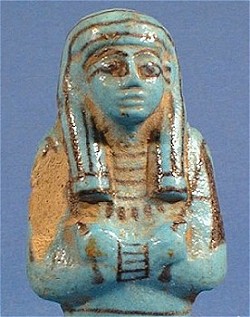
Fayence ist das Rohmaterial für die Herstellung zahlloser Gegenstände, einschließlich der riesigen Mengen von Uschebtis und Amuletten der Spätzeit. Fayence wurde in erster Linie wegen seines symbolischen Wertes geschätzt. Sie wurde als eine Manifestation des Lichtes betrachtet. Das ägyptische Wort für Fayence, 'tjehenet', bedeutet 'das Glänzende'. Fayence ist vor dem Brennen stumpf und farblos, danach aber glänzend und von leuchtender Farbe. Die Ägypter verbanden dies mit der Auferstehung der Sonne von den Toten und mit dem Licht, das für den Verstorbenen in seinem Grab so unentbehrlich war. Die leuchtend grüne Farbe wurde ebenfalls mit der Regeneration in Verbindung gebracht. Es ist daher leicht verständlich, warum den Toten so viele Fayenceobjekte mitgegeben wurden. So wurden beispielsweise in den Kammern unter der Stufenpyramide des Djoser in Saqqara und in dem sogenannten Südgrab, das zum selben Komplex gehört, Tausende von Fayencekacheln gefunden, die auf eine Weise angeordnet waren, daß sie vermutlich eine Schilflandschaft abbilden sollten. Bereits aus der späten Prädynastischen Zeit und der Archaischen Zeit (1. und 2. Dynastie) liegen Fayenceobjekte vor, hauptsächlich Perlen, Kacheln und kleine Votivgegenstände. In den folgenden Jahrhunderten wurden weiterhin Fayenceobjekte hergestellt. Der Hauptanteil der Fundgegenstände datiert in das Neue Reich und insbesondere in die Spätzeit. Fayence besteht zu über 90% aus Quarz, das in Sand und zerstoßenem Quarzit vorkommt. Ein Alkali, wie etwa Natron, wurde dann zugesetzt, hinzu kam etwas Kalk und ein Farbstoff, gewöhnlich zerkleinertes Kupfer. Letzteres gibt der Fayence ihre typische blaugrüne Farbe. Wasser wurde hinzugefügt, um eine Paste herzustellen, die von Hand oder in einer Form modelliert werden konnte. Bevor der Gegenstand gebrannt wurde, konnte er entweder mit schwarzer Farbe oder durch das Einritzen von Mustern verziert werden. Es war auch möglich, Einlagen aus einer weiteren Fayence hinzuzufügen, die beim Brand eine andere Farbe erhielt.